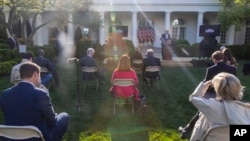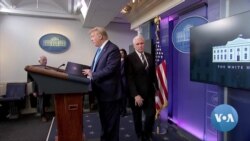The James Brady Press Briefing Room is a changed place. Most of the 49 seats are unoccupied during news conferences. The daily briefing is never given by the press secretary — but by the president himself.
U.S. President Donald Trump did not use the room to talk with reporters until COVID-19 reached pandemic proportions, although he has been loquacious with us in the Oval Office and other venues, including overseas.
For the first three years of the Trump administration, my VOA colleagues and I took turns in our assigned seat in the fourth row between Fox News Radio and the National Journal for briefings by the press secretary or other officials.
The first wave of culling due to social distancing left every other seat unoccupied and sent us to the back of the room in a seat shared with PBS.
The second wave left just two occupied seats in each of the seven rows. Now, VOA is usually in the room only when we take our turn as the radio pool reporter. Some networks have dropped out of the rotation entirely for fear of infection, so VOA volunteers as often as possible, even though that means sitting closer to wandering photographers and other people than the 2 meters recommended by the Centers for Disease Control and Prevention.
So far, three journalists who have spent time in the briefing room have reported coronavirus-like symptoms.
Getting into the room and within questioning-range of the president — either for the pool sprays or the briefings — requires passing two temperature checks, one at the Northwest Gate and the other inside the West Wing.
The Washington Post recently asked me what it was like to transition from what had been routine inside the White House to the risky.
Navigating the West Wing, I replied, has been “like trying to avoid triggering an invisible delayed-action land mine.”
Post media reporter Paul Farhi noted that I have covered natural disasters, worked in combat zones and traveled to Fukushima, Japan, in 2011 to report on the nuclear reactor meltdown. I stated that I've never felt “as much apprehension about getting to a story as riding Metro to the White House over the past week.”
I no longer ride Metro, the mass transit rail system in the Washington, D.C., region. Service has been severely reduced. For a couple of weeks, I drove from Northern Virginia to downtown D.C., until the parking garages began to pull down the shutters at 6 pm. Now, I use a ride-share and hope a car handle doesn't contain the virus and that the driver doesn’t sneeze.
A few correspondents and photographers have begun wearing masks. None of those on the podium, standing far less than 2 meters apart, wears one. So far, only one reporter has asked a question with a mask covering their mouth.
Chanel Rion, a journalist with the right-wing One America News Network, defied the social distancing diktat of the White House Correspondents' Association, which controls seating, and stood in the back of the room — ostensibly as a guest of the press secretary — and has been repeatedly called on by the president.
The WHCA removed One America News Network from the seating rotation as punishment, but Rion is undeterred. Trump knows who she is. There is a photograph of the president’s hands on her bare shoulders at the most recent Mar-a-Lago Christmas party.
The president is less familiar with some of the other reporters in the room.
“Who are you with?” he sometimes asks reporters, usually those who are African American or Asian.
He asked that question one day to my VOA colleague Patsy Widakuswara, just days after she had asked him a question on an Air Force One flight.
The briefings can drag on for more than two hours. On a few days when the weather was nice, they were moved outside to the Rose Garden.
The briefings start with the president, Vice President Mike Pence and the two physicians — Anthony Fauci and Deborah Birx — in supporting roles. The meeting is officially the White House Coronavirus Task Force briefing. Trump refers to them as news conferences. COVID-19 is the key topic.
But presidential comments, based on Trump's whims or reporters' questions, can also include oil prices, former Vice President Joe Biden's mental state, the million-dollar base salary of the head of the Tennessee Valley Authority, criticism of VOA and other broadcasters, and a possible pardon for the "Tiger King," the main character in a Netflix crime documentary.
On days when VOA doesn’t have a seat in the briefing room, I cover them from a newly configured studio located in the small library room of my rambler home in a historic hamlet halfway between the White House and Mount Vernon – the former home of the first president of the United States, George Washington.
Here, I frequently reflect that Washington had to contend with a smallpox epidemic. Yellow fever was a worry in Washington until the end of the 19th century. The Spanish flu a century ago claimed 3,000 Washingtonians. Now, we wait to see if COVID-19 will trump that toll.








